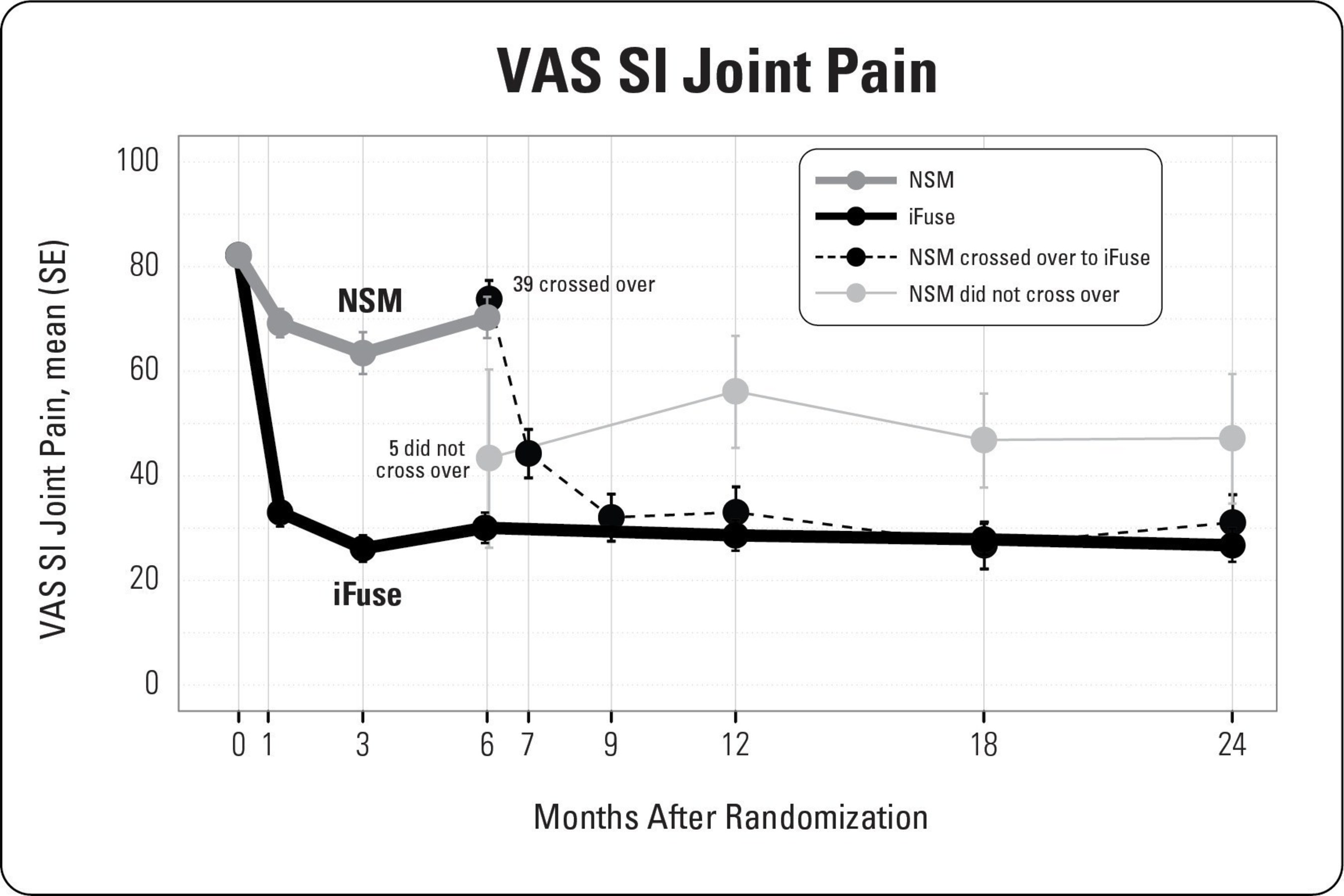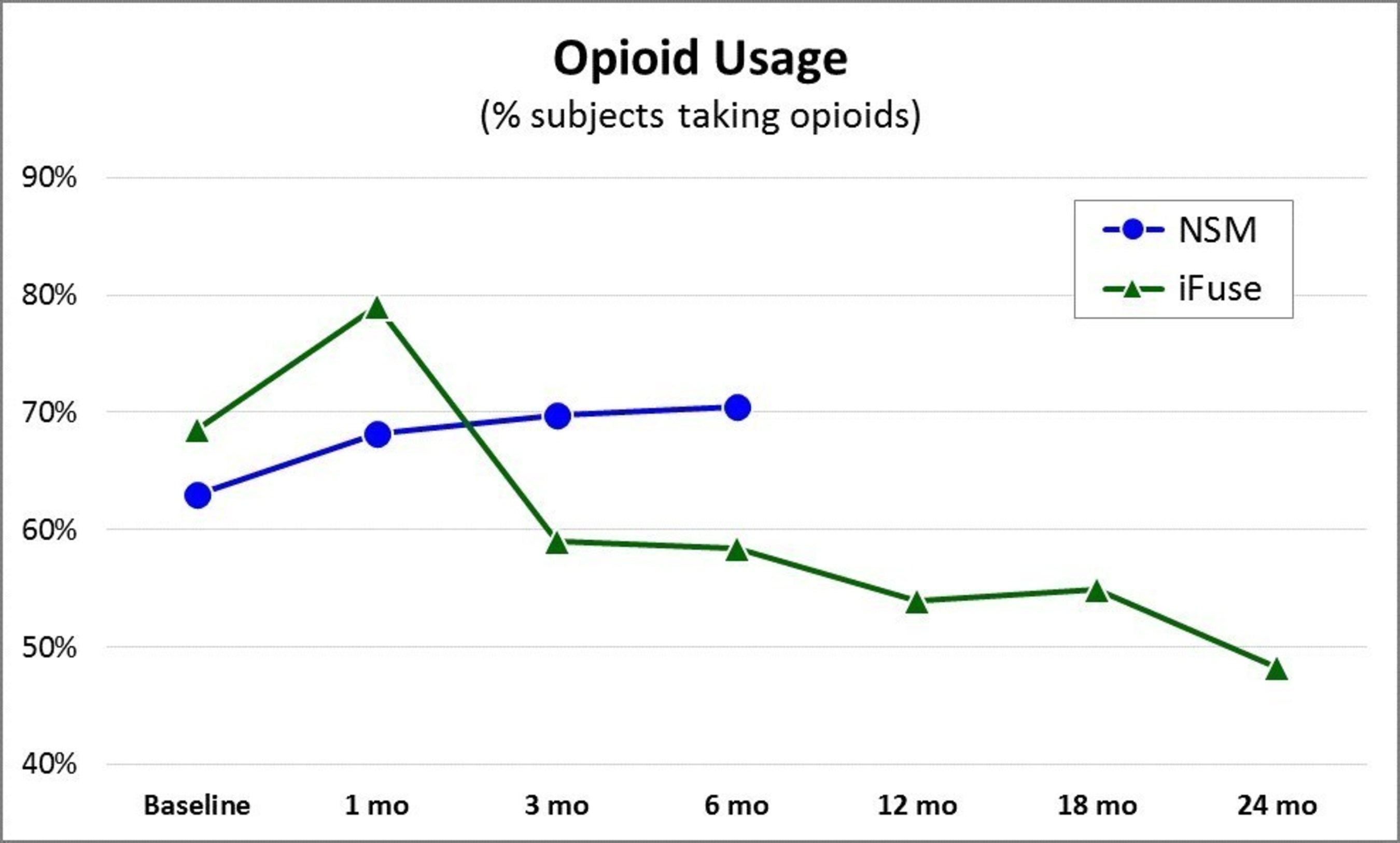SI-BONE, Inc. Announces Two-Year Results from a Randomized Controlled Trial of the iFuse Implant System® vs. Non-Surgical Management for Some Causes of Sacroiliac Joint Dysfunction
Two-Year RCT Demonstrates Long-Term Durability of iFuse, Further Validation of Previous 3, 4 and 5 Year Published Results
SAN JOSE, Calif., Aug. 24, 2016 /PRNewswire/ -- SI-BONE, Inc., a medical device company that pioneered the use of the iFuse Implant System® ("iFuse"), a patented triangular-shaped minimally invasive surgical (MIS) device indicated for fusion for certain disorders of the sacroiliac (SI) joint, announced the publication of two-year results from INSITE (Investigation of Sacroiliac Fusion Treatment - NCT01681004) a landmark prospective, multicenter, randomized controlled trial (RCT) of MIS SI joint fusion with iFuse compared to non-surgical management (NSM). Results of this Level 1, high quality study were published in the International Journal of Spine Surgery titled: Two-Year Outcomes from a Randomized Controlled Trial of Minimally Invasive Sacroiliac Joint Fusion vs. Non-Surgical Management for Sacroiliac Joint Dysfunction1. The study showed that rapid improvements in pain, disability and quality of life for the iFuse group were larger than those seen for the NSM group and were durable to two years. This large, Level 1 RCT adds to the more than 40 peer-reviewed publications on iFuse and further reinforces positive outcomes and product durability demonstrated in previously reported 3 year, 4.5 year and 5 year publications.2-4
148 subjects were enrolled, randomized 2:1 (102 iFuse/46 NSM), and treated at 19 centers in the United States including both private practice and academic institutions. In the iFuse group, the mean SI joint pain score improved from 82.3 at baseline to 30.1 at 6 months, 28.6 at 12 months and 26.7 at two years, corresponding to improvements from baseline of 52.3, 53.7 and 55.4 points, respectively (all p<.0001, Figure 1). Disability, as measured using the Oswestry Disability Index (ODI), decreased from a mean 57.2 at baseline to 29.9, 28.3 and 28.7 at months 6, 12 and 24, representing mean improvements of 27.4, 28.9 and 28.4 points, respectively (p<.0001)
The revision surgery rate was low at 3.4% (3/89) consistent with previously reported long-term results for iFuse2,5 and roughly one-third that for lumbar fusion surgery6. Two-year results also showed a 29.7% decrease from baseline in the number of study subjects taking opioids (Figure 2) which is consistent with a 28% reduction in opioid use observed in a previously reported prospective multicenter two-year study5.
"These two-year results from the INSITE study illustrate the durability of SI joint fusion with iFuse and further validate previously reported 6- and 12-month results that showed rapid improvement in pain, function and quality of life in this highly debilitated patient population," said Frank Phillips, MD of Rush University Medial Center in Chicago, IL. "This positive publication validates the consistency of the earlier publications on iFuse and will hopefully encourage health plans across the U.S. to establish coverage for this effective procedure."
About SI-BONE, Inc.
SI-BONE, Inc. (San Jose, California) is a leading sacroiliac joint medical device company dedicated to the development of tools and products for patients with low back issues related to certain SI joint disorders. The company develops, manufactures and markets minimally invasive products for the SI joint. SI-BONE, Inc. received original 510(k) clearance in November 2008 from the Food and Drug Administration (FDA) to market its iFuse Implant System. The CE mark for European commercialization was obtained in November 2010.
The iFuse Implant System is a minimally invasive surgical option that uses titanium implants with a porous surface that acts as an interference surface, designed to help decrease implant motion, and allow for biological fixation to support long term fusion. iFuse is the only commercially available SI joint fusion device in the United States with published evidence that demonstrates safety, effectiveness and economic benefits, including three large multicenter prospective studies, two of which are randomized controlled trials (RCTs). Currently, there are more than 40 peer-reviewed publications supporting positive clinical outcomes, safety, biomechanics, and the economic value of iFuse. It is the only SI joint fusion product with a unique FDA clearance recognizing that clinical studies demonstrate improved pain, patient function and quality of life.
The iFuse Implant System is intended for sacroiliac fusion for conditions including sacroiliac joint dysfunction that is a direct result of sacroiliac joint disruption and degenerative sacroiliitis. This includes conditions whose symptoms began during pregnancy or in the peripartum period and have persisted postpartum for more than 6 months. Clinical studies have demonstrated that treatment with the iFuse Implant System improved pain, patient function, and quality of life. There are potential risks associated with the iFuse Implant System. It may not be appropriate for all patients and all patients may not benefit. For information about the risks, visit: www.si-bone.com/risks
SI-BONE and iFuse Implant System are registered trademarks of SI-BONE, Inc. ©2016 SI-BONE, Inc. All Rights Reserved. 9695.082416
- Polly DW, Swofford J, Whang PG, Frank CJ, Glaser JA, Limoni RP, Cher DJ, Wine KD, Sembrano JN, and the INSITE Study Group. Two-Year Outcomes from a Randomized Controlled Trial of Minimally Invasive Sacroiliac Joint Fusion vs. Non-Surgical Management for Sacroiliac Joint Dysfunction. Int J Spine Surg. 2016;10:Article 28. doi: 10.14444/3028.
- Sachs D, Kovalsky D, Redmond A, Limoni R, Meyer SC, Harvey C, Kondrashov D. Durable Intermediate- to Long-term Outcomes after Minimally Invasive Transiliac Sacroiliac Joint Fusion using Triangular Titanium Implants. Med Devices (Auckl). 2016;9:213-22. doi: 10.2147/MDER.S109267.
- Vanaclocha-Vanaclocha V, Verdú-López F, Sánchez-Pardo M, Gozalbes-Esterelles L, Herrera JM, Rivera-Paz M, Martínez-Gómez D. Minimally Invasive Sacroiliac Joint Arthrodesis: Experience in a Prospective Series with 24 Patients. J Spine. 2014;3:185. doi: 10.4172/2165-7939.1000185.
- Rudolf L, Capobianco R. Five-Year Clinical and Radiographic Outcomes After Minimally Invasive Sacroiliac Joint Fusion Using Triangular Implants. Open Orthop J. 2014;8:375–83. doi: 10.2174/1874325001408010375.
- Duhon BS, Bitan F, Lockstadt H, Kovalsky DA, Cher DJ, Hillen T, on behalf of the SIFI Study Group. Triangular Titanium Implants for Minimally Invasive Sacroiliac Joint Fusion: 2-year Follow-up from a Prospective Multicenter Trial. Int J Spine Surg. 2016;10:Article 13. doi: 10.14444/3013.
- Martin BI, Mirza SK, Comstock BA, Gray DT, Kreuter W, Deyo RA. Reoperation rates following lumbar spine surgery and the influence of spinal fusion procedures. Spine. 2007;32(3):382-7. doi: 10.1097/01.brs.0000254104.55716.46.
One or more of the individuals named herein may be a past or present SI-BONE employee, paid consultant, investor, clinical trial investigator, or grant recipient. Research described herein was supported by SI-BONE.
Photo - http://photos.prnewswire.com/prnh/20160823/400554
Photo - http://photos.prnewswire.com/prnh/20160823/400553
SOURCE SI-BONE, Inc.
Related Links
WANT YOUR COMPANY'S NEWS FEATURED ON PRNEWSWIRE.COM?
Newsrooms &
Influencers
Digital Media
Outlets
Journalists
Opted In


Share this article